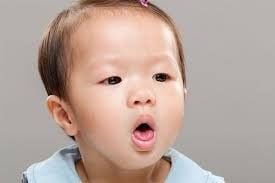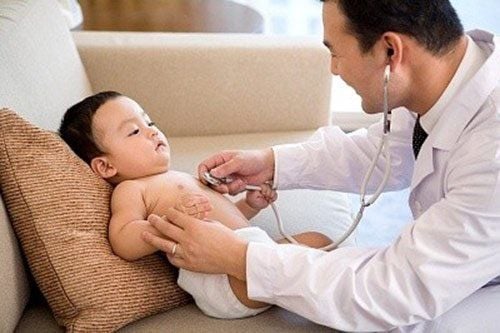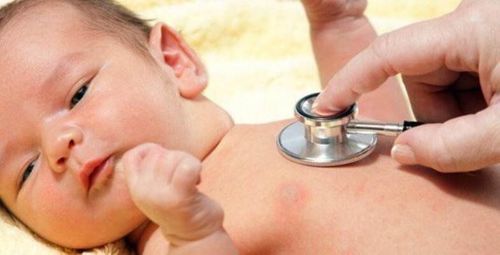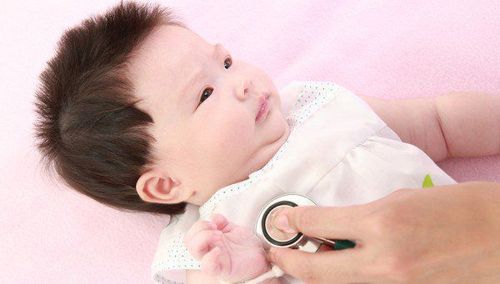This is an automatically translated article.
The article is professionally consulted by Master, Doctor Nguyen Nam Phong - Pediatrician - Department of Pediatrics - Neonatology, Vinmec Phu Quoc International General HospitalPneumonia is the leading cause of death in children worldwide. Pneumonia can appear when the child is in the middle of a prolonged respiratory illness. Learning the symptoms of the disease helps parents increase their vigilance, detect the disease early, and avoid the child turning into severe pneumonia.
1. Be alert for pneumonia in children with long-term respiratory disease
Pneumonia is an infection that causes inflammation of the alveoli and interstitial tissues in one or both lungs. Pneumonia can be mild or severe and is most common in children under 5 years of age.Pneumonia is usually caused by bacteria or viruses. Some of these bacteria and viruses can be spread by direct contact with someone who has been infected with them. Common bacteria and viruses that can cause pneumonia are:
Pneumococcal Atypical Mycoplasma Group B Streptococcus Staphylococcus aureus Respiratory syncytial virus (RSV). Most commonly seen in children under 5 years of age. Parainfluenza virus Adenovirus Influenza virus Pneumonia can sometimes be caused by fungi.
According to the World Health Organization, each year about 150 million episodes of pneumonia occur in children in the developing world, of which about 11 million children need hospital treatment. Pneumonia remains the leading cause of death in children under 5 years of age, with more children dying from pneumonia than from AIDS, malaria and measles combined. Vietnam is one of the countries with the highest number of children infected with pneumonia in the world. Every year, about 4000 children die from pneumonia in our country.
Which children are at risk for pneumonia?
A child is more likely to get pneumonia if they have:
A weak immune system, such as cancer; Ongoing (chronic) health problems, for example, asthma or cystic fibrosis; Lung or breathing problems. In addition, children under 1 year of age are at increased risk of disease if exposed to secondhand smoke. This is especially true if their mother smokes.
2. Symptoms of pneumonia in children

-Cough from moderate to severe, usually cough is severe, but sometimes the child does not cough.
-Continuous rapid breathing, parents need to distinguish from transient rapid breathing when the child has a high fever. Many large-scale studies have proven that tachypnea is the earliest symptom of pneumonia, even earlier than X-ray or listening to the lungs with a stethoscope. Parents can use a stopwatch to check a child's breathing for one minute, when the child is lying still, without strenuous activity. Children are called tachypnea when:
Children under 2 months old: breathing rate > 60 times/minute. Children from 2 to 11 months old: breathing rate >50 times/minute. Children from 12 months to 5 years old: breathing rate > 40 times/minute. Exercising breathing: when breathing hard, the child's nostrils rise and fall, groan, contract the intercostal muscles, contract the chest cavity, contract the breastbone. When the child breathes in, the chest of the child does not bulge as usual, but is concave because the diaphragm separating the abdomen and the ribcage is also involved in the breathing process. Stridor, which is usually a sign of a viral infection but is also sometimes present in pneumonia. Fever of moderate to high fever. Chest pain during and between coughs. Vomiting after strong coughs and also between coughs. If the child has all of the above symptoms, there is a high chance that the child has pneumonia. If a child has 1 or 2 symptoms in which there is no difficulty breathing, rapid breathing, labored breathing, it is less likely to have pneumonia. Rapid breathing, labored breathing are important manifestations of the disease, these are compensatory reactions of the body when the body is not supplied with enough oxygen, if not treated promptly, the patient may become exhausted. respiratory failure, breathing stops, apnea.
3. When does the child need to be hospitalized?
If the child has all of the above symptoms, has rapid breathing or labored breathing but there is no purple color on the lips or face, parents should take them to a medical facility for examination within the same day, as soon as possible. Exercising breathing with signs of chest constriction indicates severe pneumonia, the child needs to be treated immediately.If the child has many symptoms of childhood pneumonia but does not have rapid breathing or exertion, no cyanosis on the lips and face. If it is in the evening, there is no need to take the child to the doctor right away, but can wait for the examination the next day.
If the child has symptoms of childhood pneumonia, rapid breathing, labored breathing, purple lips and face, it is necessary to immediately take the child to the emergency department of the nearest medical facility.
Other danger signs indicating that a child is in a critical condition that requires immediate medical assistance are:
Babies under 2 months of age are not sucking well or are not nursing, convulsions, wheezing, lethargy, and difficulty sleeping. awakened, feverish or cold. Children from 2 to 5 months of age: the child cannot eat or drink, has convulsions, has a whistling breath, and sleeps.
4. Caring for children with pneumonia at home?

Give the child the right antibiotic, the right antibiotic prescribed by the doctor, the right dose, and the right number of times. in a day, enough days. Absolutely do not stop the medicine even if the child's condition improves. Use other drugs to treat symptoms of fever, cough, wheezing,... as directed by your doctor. Enhance nutrition for children, feed them enough nutrients, drink plenty of water, if the child is still breast-feeding, breastfeed often. Water supply plays an important role, water helps to thin phlegm, soothe throat, relieve cough and avoid dehydration in children. Nasal drops with salt water help the baby's nose clear, the baby eats and sucks more easily. Parents note about the use of cough medicine for children. Coughing is a beneficial response, helping to expel sputum, airways are open, children will breathe easier. Therefore, only when the child coughs too much, the cough makes the child vomit, insomnia, sore throat, chest tightness, ... then give the child cough medicine. Do not abuse cough medicine to suppress the cough reflex. beneficial to the body. When using cough medicine, you should use cough syrup with herbal ingredients that are safe for children. Have the child re-examine according to the doctor's schedule, when the child's symptoms worsen, take the child to the doctor immediately.
5. Prevention of pneumonia in children

In addition, parents should also add some supporting foods containing lysine, essential micro-minerals and vitamins such as zinc, chromium, selenium, B vitamins,... The need for nutrients at the same time supports the immune system, enhances resistance, reduces the risk of upper respiratory tract infections, pneumonia, bronchitis, flu.
Please regularly visit Vinmec.com website and update useful information to take care of your baby and family.
Please dial HOTLINE for more information or register for an appointment HERE. Download MyVinmec app to make appointments faster and to manage your bookings easily.














